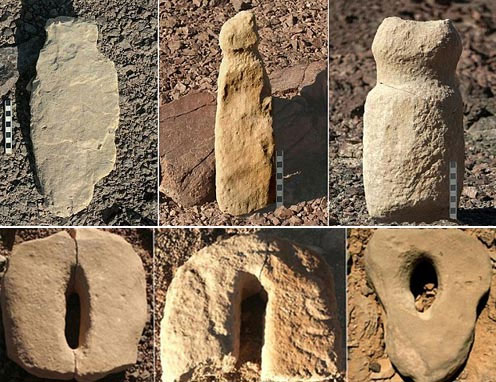Discover 100 sexual worship places in Israel
Archaeologists have uncovered nearly 100 prehistoric worship sites, containing countless statues carved with male and female genitalia in the Eilat Mountains in Israel's Negev desert.
The above relics have been dated to about 8,000 years. Experts are extremely surprised when they find countless stone structures and artifacts in these places.
Among the remarkable excavated artifacts are large stone circles, with a diameter of 1.5 to 2 meters, located near the penis figurines pointing in their direction. In addition, the team also found vertical stone statues as high as 0.8m high, stone bowls and carved stone figures.

A number of male and female sexual organs are discovered in ancient worship places in Israel.(Photo: Daily Mail)
The team, led by Uzi Avner from Arava Science Center - Dead Sea, said, although comprehensive research on the style of stone artifacts is still ongoing, the results of the examination The first shows two symbolic aspects: One is about fertility, symbolized by stone slabs with long holes like the pussy shape (the outer door of the female genitalia) combined with the penis image.
The second is about death, symbolized by burying stone objects as well as placing them in an upside down position. For example, a carved figure of a human figure was buried, just sticking its head out of the ground.
The ancient ruins are often huddled close together. And in an area of only 0.8 km 2 , the archaeological team discovered 44 different places of worship.
"Considering the terrain, the environmental conditions and the small number of Neolithic habitats known in the southern Negev region, the dense existence of worship sites in this region is really strange. " , the research team wrote in the Journal of the Israel Prehistoric Society.
Archaeological experts are trying to decipher any meaning of newly excavated stone artifacts and structures. However, they said, the two aspects of symbolic fertility and sugar death appear to be the same in all sites in the region.
The worship points all have a wide viewing angle, referring to the landscape may be a factor considered by prehistoric people to choose where to build them. According to the research team, the fact that these places of worship are still visible today proves that they have been used frequently by many people, for short events in critical time periods.
The team expects to find more similar worship sites in the mountains of the Negev, southern Jordan and Sinai regions.
- 'Strange worship of aircraft' on the remote island
- 'Deciphering' sex attackers
- Discovering the ancient Greek worship complex in the Republic of Cyprus
- Israel strives to build the world's tallest solar tower
- Discover a 2,000 year old paved road
- Visit the 8 mysterious 'hidden places' on Earth
- Discover the ancient city dating back to 5,000 years in Israel
- The Vietnamese worship tradition is recognized as a World Heritage Site
- 'Underwear rules' everyone needs to know to help children avoid sexual abuse
- 'Chemical castration' - Solution for child sexual crimes
- Explore the upper society of the Stone Age in Israel
- Headache reduces female sexual desire
 Discovered an ancient centipede fossil 99 million years old
Discovered an ancient centipede fossil 99 million years old Discovered bat-like dinosaurs in China
Discovered bat-like dinosaurs in China Discovered a 200-year-old bronze cannon of the coast
Discovered a 200-year-old bronze cannon of the coast Discover 305 million-year-old spider fossils
Discover 305 million-year-old spider fossils